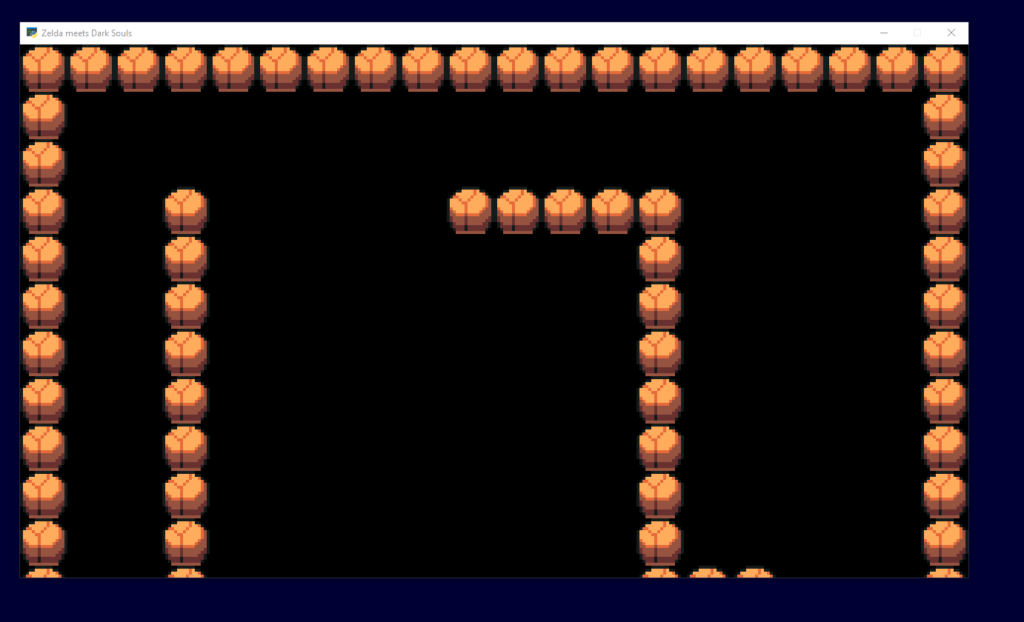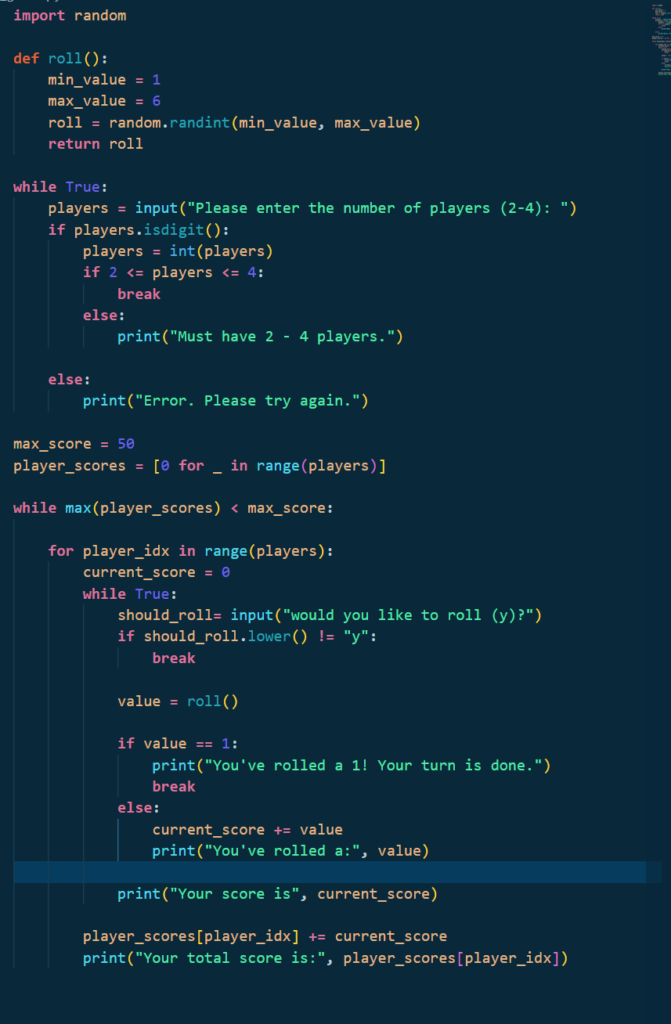Making a python program of a Zelda type game!!!! (tutorial by Clear Code)
‘main.py’
import pygame, sys
from settings import *
class Game:
def __init__(self):
pygame.init()
self.screen = pygame.display.set_mode((WIDTH, HEIGHT))
pygame.display.set_caption('Zelda meets Dark Souls')
self.clock = pygame.time.Clock()
def run(self):
while True:
for event in pygame.event.get():
if event.type == pygame.QUIT:
pygame.quit()
sys.exit()
self.screen.fill('black')
pygame.display.update()
self.clock.tick(FPS)
if __name__ =='__main__':
game = Game()
game.run()This is the main file (as it says in the name) that runs the game. It takes the parameters from both settings.py and debug.py. Basically the brain of the program.
‘settings.py’
WIDTH = 1280
HEIGHT = 720
FPS = 60
TILESIZE = 64
WORLD_MAP = [
['x', 'x', 'x', 'x', 'x', 'x', 'x', 'x', 'x', 'x', 'x', 'x', 'x', 'x', 'x', 'x', 'x', 'x', 'x', 'x'],
['x', ' ', ' ', ' ', ' ', ' ', ' ', ' ', ' ', ' ', ' ', ' ', ' ', ' ', ' ', ' ', ' ', ' ', ' ', 'x'],
['x', ' ', 'p', ' ', ' ', ' ', ' ', ' ', ' ', ' ', ' ', ' ', ' ', ' ', ' ', ' ', ' ', ' ', ' ', 'x'],
['x', ' ', ' ', 'x', ' ', ' ', ' ', ' ', ' ', 'x', 'x', 'x', 'x', 'x', ' ', ' ', ' ', ' ', ' ', 'x'],
['x', ' ', ' ', 'x', ' ', ' ', ' ', ' ', ' ', ' ', ' ', ' ', ' ', 'x', ' ', ' ', ' ', ' ', ' ', 'x'],
['x', ' ', ' ', 'x', ' ', ' ', ' ', ' ', ' ', ' ', ' ', ' ', ' ', 'x', ' ', ' ', ' ', ' ', ' ', 'x'],
['x', ' ', ' ', 'x', ' ', ' ', ' ', ' ', ' ', ' ', ' ', ' ', ' ', 'x', ' ', ' ', ' ', ' ', ' ', 'x'],
['x', ' ', ' ', 'x', ' ', ' ', ' ', ' ', ' ', ' ', ' ', ' ', ' ', 'x', ' ', ' ', ' ', ' ', ' ', 'x'],
['x', ' ', ' ', 'x', ' ', ' ', ' ', ' ', ' ', ' ', ' ', ' ', ' ', 'x', ' ', ' ', ' ', ' ', ' ', 'x'],
['x', ' ', ' ', 'x', ' ', ' ', ' ', ' ', ' ', ' ', ' ', ' ', ' ', 'x', ' ', ' ', ' ', ' ', ' ', 'x'],
['x', ' ', ' ', 'x', ' ', ' ', ' ', ' ', ' ', ' ', ' ', ' ', ' ', 'x', ' ', ' ', ' ', ' ', ' ', 'x'],
['x', ' ', ' ', 'x', ' ', ' ', ' ', ' ', ' ', ' ', ' ', ' ', ' ', 'x', 'x', 'x', ' ', ' ', ' ', 'x'],
['x', ' ', ' ', ' ', ' ', ' ', ' ', 'x', ' ', 'x', ' ', ' ', ' ', ' ', ' ', ' ', ' ', ' ', ' ', 'x'],
['x', ' ', ' ', ' ', ' ', ' ', 'x', 'x', 'x', 'x', 'x', ' ', ' ', ' ', ' ', ' ', ' ', ' ', ' ', 'x'],
['x', ' ', ' ', ' ', ' ', ' ', ' ', 'x', 'x', 'x', ' ', ' ', ' ', ' ', ' ', ' ', ' ', ' ', ' ', 'x'],
['x', ' ', ' ', ' ', ' ', ' ', ' ', ' ', 'x', ' ', ' ', ' ', ' ', ' ', ' ', ' ', ' ', ' ', ' ', 'x'],
['x', ' ', ' ', ' ', ' ', ' ', ' ', ' ', ' ', ' ', ' ', ' ', ' ', ' ', ' ', ' ', ' ', ' ', ' ', 'x'],
['x', ' ', ' ', ' ', ' ', ' ', ' ', ' ', ' ', ' ', ' ', ' ', ' ', ' ', ' ', ' ', ' ', ' ', ' ', 'x'],
['x', ' ', ' ', ' ', ' ', ' ', ' ', ' ', ' ', ' ', ' ', ' ', ' ', ' ', ' ', ' ', ' ', ' ', ' ', 'x'],
['x', 'x', 'x', 'x', 'x', 'x', 'x', 'x', 'x', 'x', 'x', 'x', 'x', 'x', 'x', 'x', 'x', 'x', 'x', 'x']]The settings and world map for the game. These can be changed at any time by just changing the values.
‘debug.py’
import pygame
pygame.init()
font = pygame.font.Font(None, 30)
def debug(info,y = 10, x = 10):
display_surface = pygame.display.get_surface()
debug_surf = font.render(str(info), True, 'White')
debug_rect = debug_surf.get_rect(topleft = (x,y))
pygame.draw.rectThis is for the window and everything.
Files that were added:
‘level.py’
import pygame
from settings import *
from tile import Tile
from player import Player
class Level:
def __init(self):
# Get the display surface
self.display_surface = pygame.display.get_surface()
'''Sprite group setup'''
self.visible_sprites = pygame.sprite.Group()
self.obsracles_sprites = pygame.sprite.Group()
# sprite setup
self.create_map()
def create_map(self):
for row_index,row in enumerate(WORLD_MAP):
for col_index,col in enumerate(row):
x = col_index * TILESIZE
y = row_index * TILESIZE
if col == 'x':
Tile((x,y),[self.visible_sprites])
def run (self):
'''Update and draw the game'''
self.visible_sprites.draw(self.display_surface)Basically the core of this program. Will have all the sprites for the level (player.py and tile.py are important too, but if the levels don’t work, nor will the other files…)
’tile.py’
import pygame
from settings import *
class Tile(pygame.sprite.Sprite):
def __init__(self, pos, groups):
super().__init__(groups)
self.image = pygame.image.load('../graphics/test/rock.png').convert_alpha()
self.rect = self.image.get_rect(topleft = pos)Will have all the info for the tiles (the x’s in settings.py) implemented in the game. Levels will display the sprites using ‘visible_sprites’.
‘player.py’
import pygame
from settings import *
class Player(pygame.sprite.Sprite):
def __init__(self, pos, groups):
super().__init__(groups)
self.image = pygame.image.load('../graphics/test/player.png').convert_alpha()
self.rect = self.image.get_rect(topleft = pos)Same as tile.py, but with the player character. Level.py will also display the sprites there.
Result:

*Still a WIP

